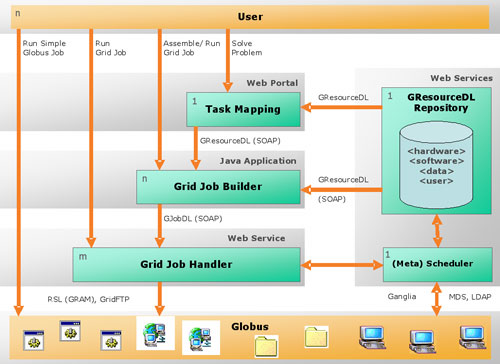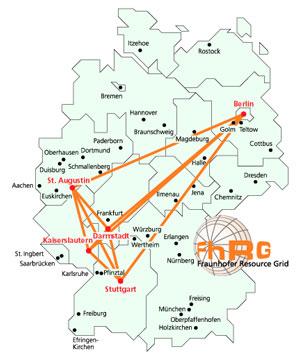| |||||
Fraunhofer Grid Alliance – From Grid-Based e-Science to Industrial Applicationsby Franz-Josef Pfreundt, Anette Weisbecker, Jürgen Falkner, Thilo Ernst, Uwe Der, Andreas Hoheisel, Klaus-Peter Eckert and Wolfgang Ziegler The ICT group of German-based Fraunhofer Society, Europe’s largest research organization for applied research, has announced the foundation of the Fraunhofer Grid Alliance, a network of institutes that combines the special Grid-related skills of different institutes within the Fraunhofer Society and extends the Fraunhofer Resource Grid. In the year 2001 five Fraunhofer Institutes launched a project named ‘I-Lab’ which was funded by the German Ministry for Science and Education (BMBF). This project developed an Internet laboratory software on the basis of a Fraunhofer Computing Grid. The objective of the project was to provide a user-friendly computing grid which gives users access to the grid resources and provides appropriate solutions to their computing problems. The Fraunhofer Resource Grid (FhRG) emerged from these efforts, and substantial applications have been running on the FhRG since 2002. The FhRG Web portal can be reached at http://www.fhrg.fhg.de. Today, the FhRG combines the computing and storage infrastructure of the six participating institutes: ITWM (Kaiserslautern), IAO (Stuttgart), FIRST (Berlin), IGD and SIT (both in Darmstadt) and SCAI (Sankt Augustin). Within the I-Lab project, Fraunhofer developed a middleware package based on, but not strictly dependent on the Globus Toolkit. The result of these efforts was to a large extent made publicly available in the beginning of 2004 and is distributed through the eXeGrid Open Source Project at http://www.exegrid.net. The software packages developed for the Fraunhofer Resource Grid and which are continually being developed further in the eXeGrid Project cover the areas of grid workflow systems, grid workflow editing, scheduling of jobs, resource brokerage, an intelligent job execution system, a Web portal with user management, management of grid resource descriptions, resource search mechanisms including the mapping of a user’s tasks to suitable grid resources, and finally, an advanced security concept including the respective implementation. The basis on which all these subsystems work together is a set of resource and workflow description languages referred to as the ‘Grid Application Definition Language’ (GADL), and a component model designed for easy integration of legacy applications into complex grid workflows. The Fraunhofer Resource Grid can be accessed in a number of ways, depending on the user’s level of experience. Figure 1 gives a brief overview over the FhRG/eXeGrid architecture and the information flow within it.
As shown, the user can access all the grid’s services through the Web portal, then going through a process of ‘task mapping’ that returns appropriate grid resources to solve the task defined by the user. After having chosen the resources, the user opens the Grid Job Builder – a graphical workflow editing tool – from within the portal. With this tool complex grid jobs can be created, which are then submitted for execution by the Grid Job Handler Web service. This Web service dynamically deploys grid workflows to the hardware resources that are most suitable for the execution of jobs at the time. The Grid Job Handler communicates with resource brokers and schedulers and translates the above grid workflow into GLOBUS commands so it can be run on the underlying grid infrastructure. As shown in Figure 1, each level can in principle be bypassed, which may be helpful for advanced users or special application scenarios. In addition to the efforts within the I-Lab project, other institutes in the Fraunhofer Society, namely Fraunhofer SCAI and Fraunhofer FOKUS, have been involved in Grid-related efforts, with SCAI covering supercomputing problems such as the development of meta-message passing and code-coupling algorithms for grid environments and meta-scheduling for co-allocation of various resources including network links or visualization devices. For topics such as the authentication, authorization and accounting of users, the definition and supervision of service-level agreements and service qualities, network monitoring, and the mobile access to Grid services, synergies can be expected between the telecommunication experience of FOKUS and the development of corresponding solutions in the Grid community. The same is true for research in the areas of programming models, component technology and autonomic communication. Together, the institutes mentioned above now form the ‘Fraunhofer Grid Alliance’ (see Figure 2), which coordinates the skills and strengths of the partner institutes to offer combined grid technology and services to public and industrial customers.
The members of the Fraunhofer Grid Alliance currently participate in European-level Grid projects such as EGEE (Enabling Grids for e-Science in Europe), SIMDAT (Data Grid for Process and Product Development Using Numerical Simulation and Knowledge Discovery), K-Wf Grid (Knowledge-based Workflow System for Grid Applications) and the CoreGRID European Network of Exellence. In addition, the Fraunhofer Grid Alliance is strongly involved in the German ‘D-Grid’ initiative for Grid-based e-Science. The individual institutes also use technology and experience gained within Alliance activities in smaller, regional-scale projects, often involving SMEs. As an example, one of the most demanding FhRG pilot applications is the Grid-based environmental risk analysis and management system ERAMAS, which is being developed by Fraunhofer FIRST together with two environment consulting companies. FhRG technology has already been successfully applied to solve engineering problems from a broad range of disciplines, for example, casting process optimization, micro-structure simulation and drug design. Making the Grid and e-science vision a reality – not only in research, but also in industrial sectors such as engineering and life science – will remain the primary objective of the Fraunhofer Grid Alliance in years to come. Links: Please contact: | |||||




